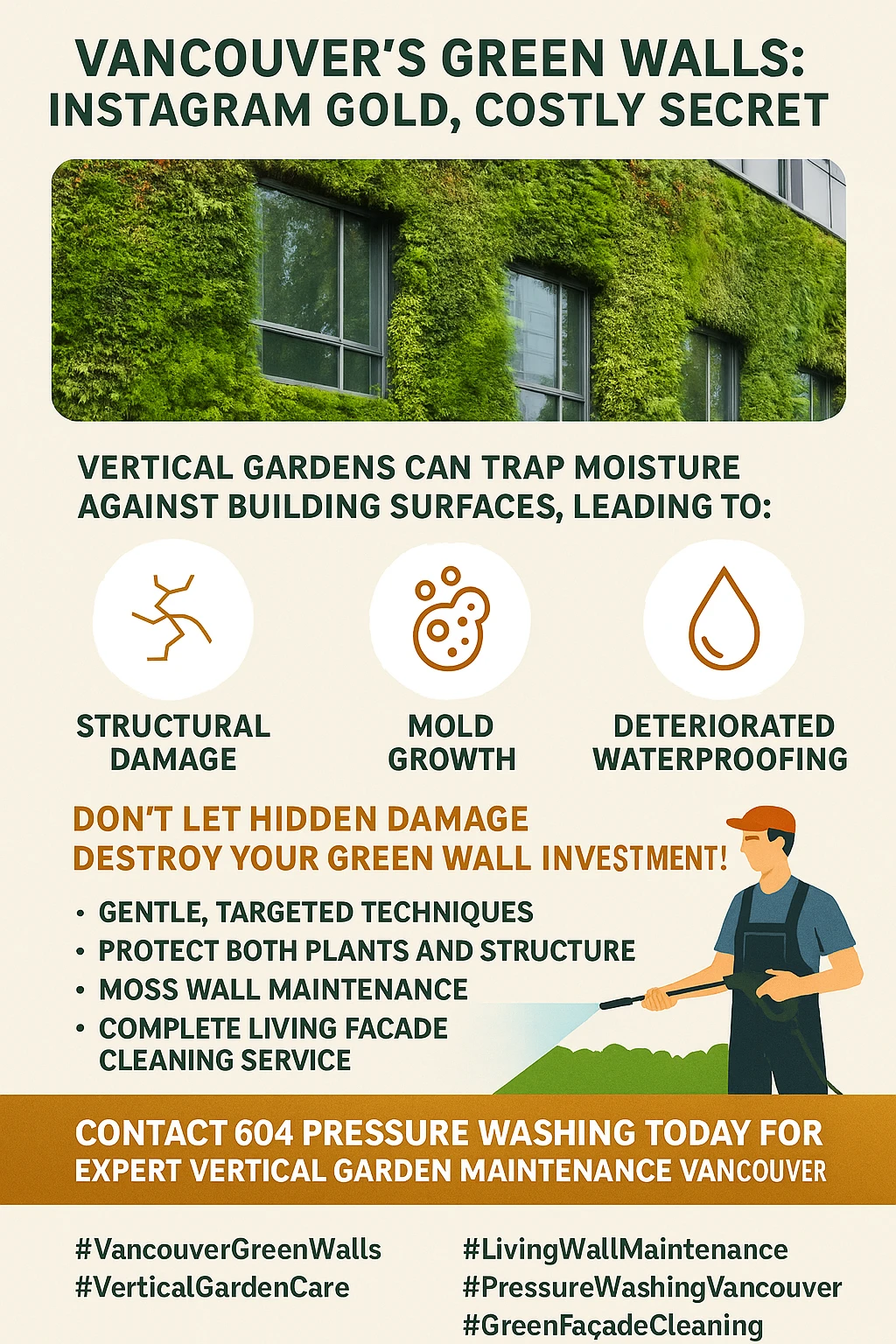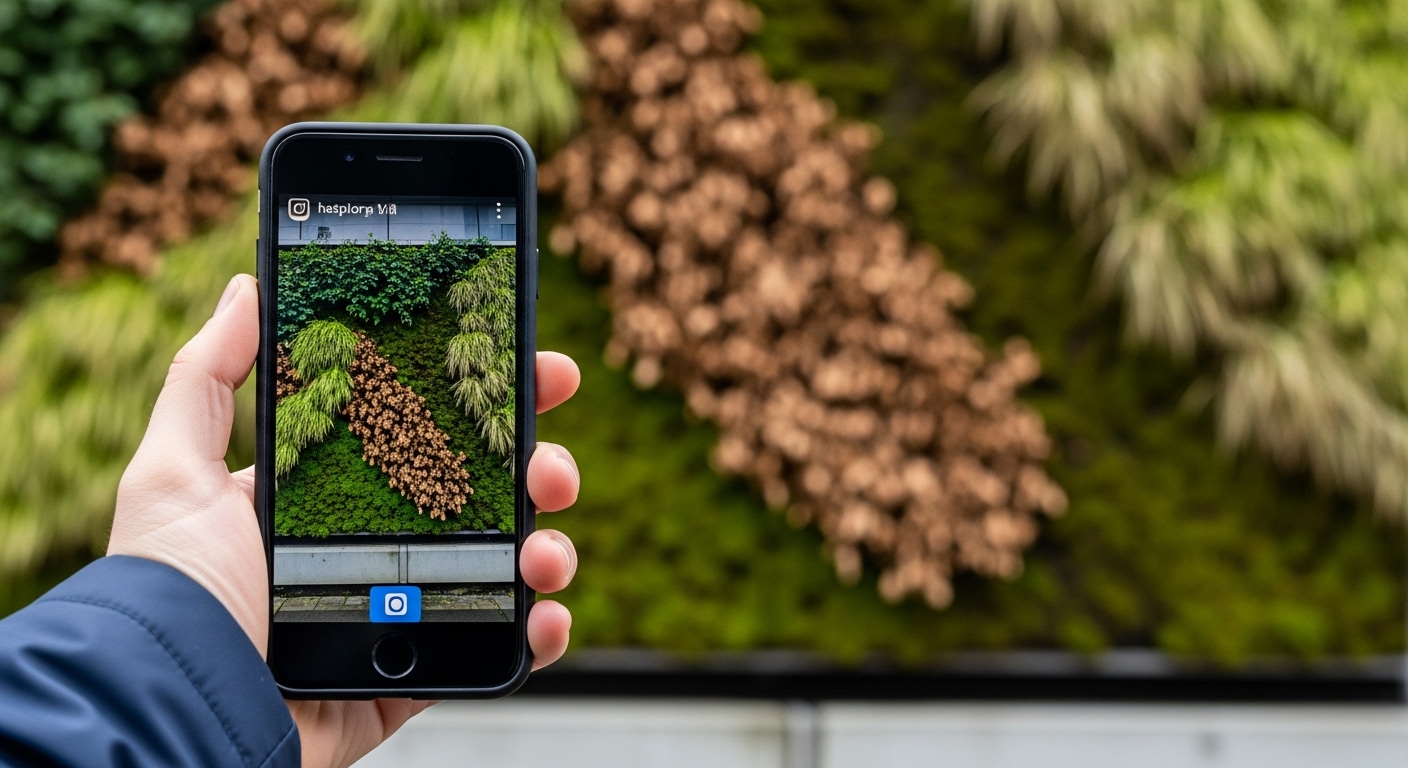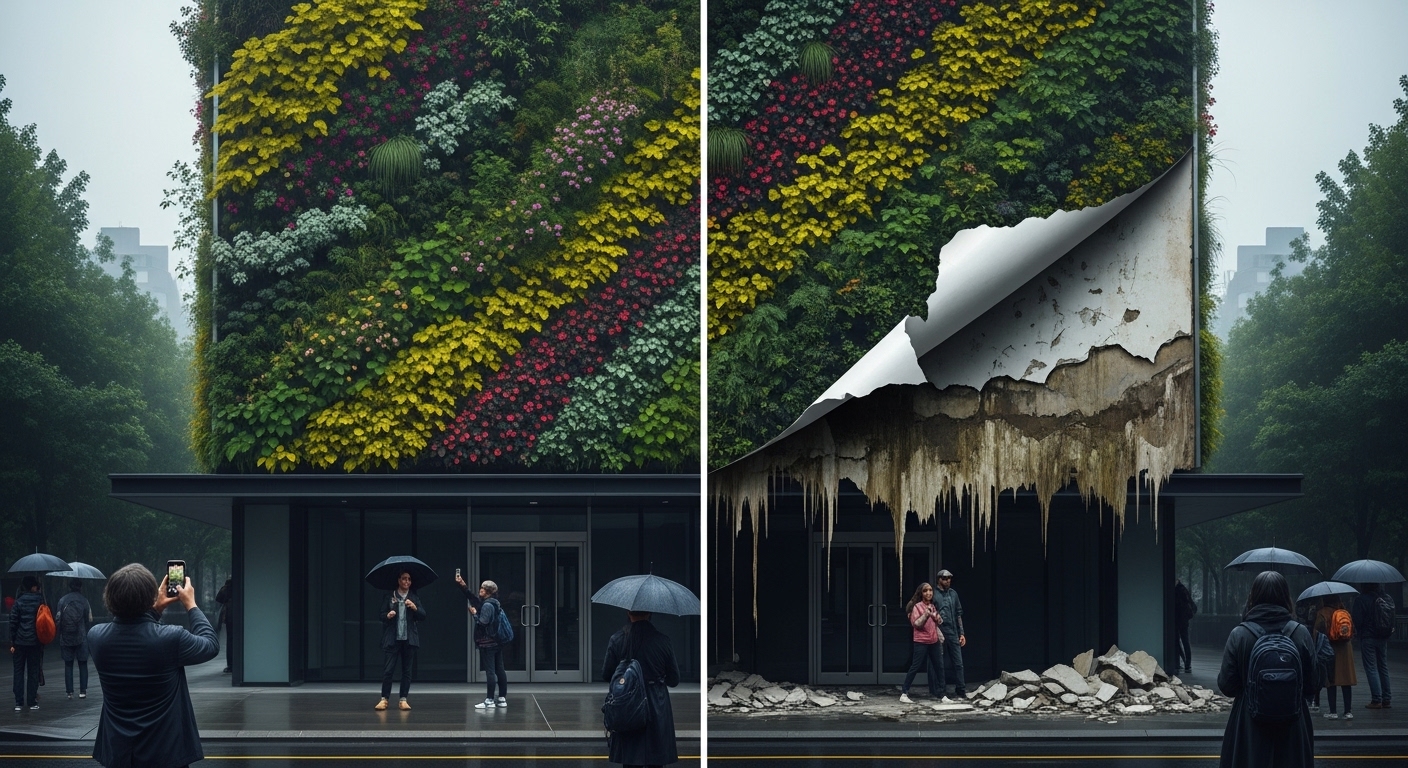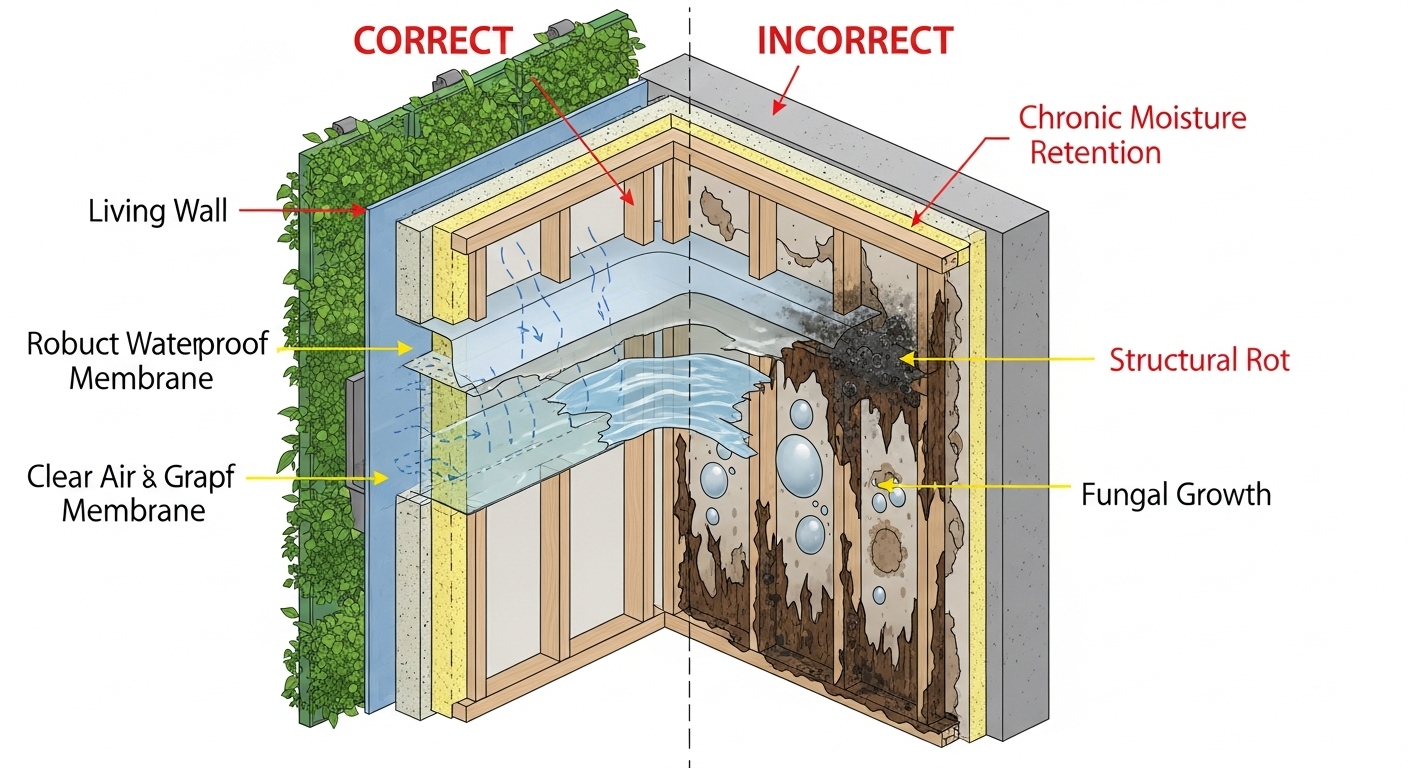Why Vancouver’s Instagram-Famous Green Walls and Living Facades Are Creating Hidden Structural Damage (And How Specialized Pressure Washing Preserves Your Vertical Garden Investment)
Mesmerized by those picture-perfect living walls gracing Vancouver’s trendiest spots, from Apple’s Pacific Centre store to boutique cafes in Gastown? Here’s the shocking reality behind those Instagram backdrops that could be slowly destroying the buildings they’re meant to beautify.
Vancouver’s urban landscape has transformed dramatically over the past decade, with living walls adorning everything from the Vancouver International Airport’s massive 18-meter installation to intimate restaurant patios throughout the city. These vertical gardens create stunning backdrops for social media enthusiasts and represent the city’s commitment to green infrastructure. However, beneath the lush, Instagram-worthy exteriors lies a more troubling reality that many property owners discover only after costly damage has already occurred.
The problem isn’t with living walls themselves – it’s with the massive disconnect between the aesthetic appeal driving installations and the intensive maintenance these systems actually require. Vancouver’s unique climate, combined with inadequate cleaning protocols and neglected maintenance schedules, creates perfect conditions for structural damage that can cost thousands more than the original installation. From chronic moisture retention causing plaster deterioration to irrigation failures that impact property insurance, the hidden costs of improperly maintained living walls are staggering.
This comprehensive guide reveals the specific challenges facing living wall owners in Vancouver’s climate, explores why standard pressure washing techniques can destroy these delicate systems, and provides expert insights on specialized maintenance protocols that protect both your investment and your building’s structural integrity. Whether you’re considering installation or dealing with an existing system, understanding these critical factors can save you from joining the growing number of property owners facing unexpected repair bills.
Key Outtakes:
- Living walls can cause chronic moisture retention leading to plaster, drywall, and exterior wall damage when not properly maintained with specialized cleaning protocols
- Vancouver’s wet climate creates ideal conditions for moss, algae, and fungal growth that accelerate structural deterioration if left unchecked
- Specialized soft-washing techniques (150-300 PSI) are required for living walls versus standard pressure washing (1,300-2,800 PSI) to prevent plant damage and system failure
- Professional living wall maintenance costs $1.50-$3.00 per square foot annually, significantly less than structural repairs averaging $400-$1,200 for house exteriors
- Green walls need effective management to remain living systems and avoid drying out, which significantly increases fire spread risk and impacts property insurance

The Instagram Effect: Why Vancouver’s Living Wall Boom Is Outpacing Proper Maintenance Planning
Vancouver has emerged as a North American leader in vertical garden design, with installations that regularly go viral on social media platforms. The city’s commitment to green infrastructure has resulted in some truly spectacular displays that capture international attention. However, this social media-driven popularity has created an unexpected problem: property owners are prioritizing visual impact over practical maintenance considerations, leading to installations that look amazing initially but deteriorate rapidly without proper care.

The scale and prominence of Vancouver’s living wall installations is truly impressive. Vancouver International Airport features an 18-meter-high living wall with 28,249 individual plants, making it the first Canadian airport with this type of green infrastructure. Green Over Grey installed Vancouver’s largest living wall at Apple Pacific Centre store, establishing the city as a showcase for innovative vertical garden design. The Semiahmoo Library in White Rock features a 3,000 square foot living wall with over 10,000 plants representing 120 different species, previously holding the title of North America’s largest installation.
The social media appeal of these installations has created a troubling trend where aesthetics override practical maintenance planning. Living walls require monthly professional maintenance visits at minimum, but many property owners prioritize the Instagram-worthy installation over developing realistic long-term care budgets. Design complexity and visual impact often take precedence over maintenance accessibility, resulting in installations that require expensive scaffolding and specialized equipment for routine care. The cost of this equipment can add $300-$1,000 to each maintenance visit, dramatically increasing the lifetime cost of ownership.
This Instagram-effect has created a significant gap between installation enthusiasm and maintenance reality. Professional horticulturist maintenance visits are recommended monthly but are frequently neglected due to cost concerns or simple oversight. Annual maintenance costs of $1.50-$3.00 per square foot are minimal compared to potential structural repairs, yet many property owners fail to budget adequately for ongoing care. Living walls can last 10-15 years with proper maintenance, but their lifespan decreases dramatically without consistent professional attention, sometimes requiring complete replacement within just a few years of installation.
The modular panel systems that create such stunning visual displays cost $250-$350 per square meter for materials alone, yet the ongoing maintenance requirements are frequently underestimated or ignored entirely. This disconnect between the initial investment in creating an Instagram-worthy installation and the reality of ongoing maintenance responsibilities has left many Vancouver property owners with deteriorating systems that damage both the vertical garden and the underlying building structure.
Vancouver’s Climate: A Perfect Storm for Living Wall Deterioration

Understanding Vancouver’s specific climate challenges is crucial for anyone considering or maintaining a living wall system, as the city’s weather patterns create unique conditions that dramatically accelerate both plant growth and deterioration. The combination of high rainfall, moderate temperatures, and extended periods of moisture creates an environment where neglected maintenance quickly becomes a serious structural threat. These climate factors, while beneficial for plant growth when properly managed, can destroy living wall systems and damage buildings when maintenance protocols aren’t followed consistently.
Vancouver receives 1,189mm (46.8 inches) of rain annually at the airport, with North Vancouver receiving double that amount at 2,477mm (97.5 inches). This substantial rainfall creates constant moisture management challenges for vertical garden systems, as the irrigation systems must be carefully balanced to prevent both drought stress and waterlogging. The city experiences 169 rainy days per year, making it Canada’s third most rainy city and creating persistent moisture conditions that require vigilant monitoring and maintenance.
The seasonal precipitation patterns add another layer of complexity to living wall maintenance. November and December average 182mm of precipitation each, creating peak periods when moisture-related structural damage is most likely to occur. During these wet months, living wall systems can become oversaturated, leading to increased weight loads on building structures and creating ideal conditions for fungal growth and root rot. Conversely, July and August are the driest months with as little as 41mm of precipitation, requiring intensive irrigation management to prevent plant stress and system failure.
Vancouver’s temperate oceanic climate creates ideal conditions for moss, mold, and algae growth on both living walls and surrounding building structures. The city’s growing season averages 221 days, from March 29 to November 5, requiring year-round irrigation management and cleaning protocols. Winter Arctic outflows occur 1-3 times per season, potentially damaging improperly maintained living wall systems with sudden temperature drops that can freeze inadequately protected irrigation lines and damage sensitive plant materials.
The persistent moisture and moderate temperatures create perfect conditions for rapid organic growth that can overwhelm neglected living wall systems. Green algae, red algae, and black algae commonly affect exterior walls in Vancouver’s climate, with black algae being particularly difficult to remove without specialized cleaning techniques. North-facing installations receive less direct sunlight, dramatically accelerating moss buildup that can cover vertical surfaces within months if left untreated. These conditions require cleaning protocols specifically designed for Vancouver’s climate, rather than generic maintenance approaches that may be adequate in drier regions.
Hidden Structural Damage: What Property Owners Don’t See Until It’s Too Late
The most insidious aspect of living wall problems is that the most serious damage often occurs hidden from view, manifesting as structural issues that become apparent only after expensive repairs are necessary. Property owners typically focus on the visible aspects of their vertical gardens – plant health, aesthetic appearance, and obvious maintenance needs – while missing the gradual deterioration affecting building structures behind and around the installation. This hidden damage can accumulate over months or years before becoming apparent, often when the original installers are no longer involved and the property owner faces unexpected costs that far exceed the original installation investment.

Chronic moisture retention represents one of the most

